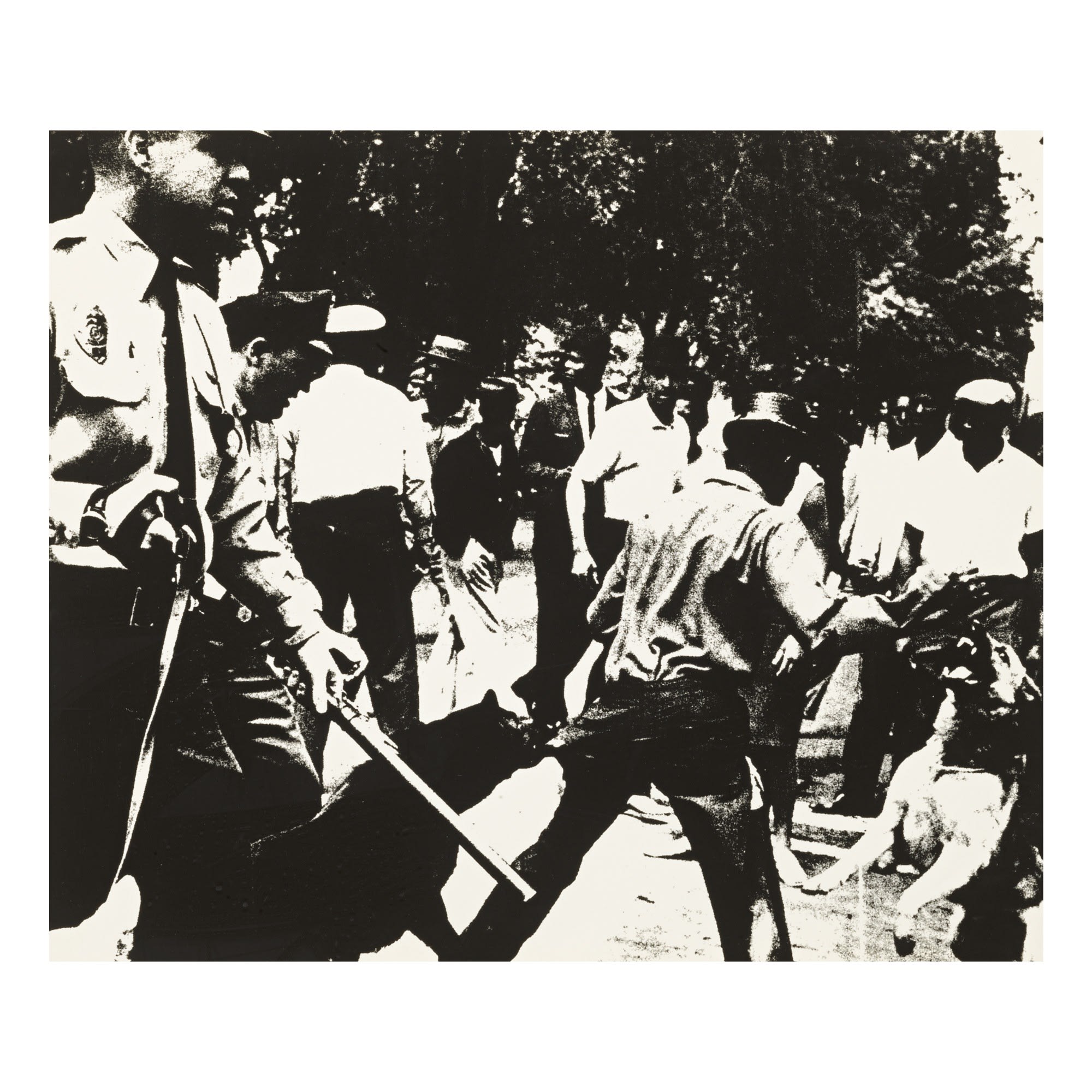
“When you see a gruesome picture over and over again, it doesn’t really have any effect.”
Electric Chair
First produced on canvas in 1964, Electric Chair shows a solitary electric chair in an empty room, its straps lifelessly hanging down next to a small wooden table and a sign that says, “SILENCE”. Produced as part of the Death and Disaster series that Warhol began work on in 1962, the work is a noticeable departure from his more upbeating and comforting works such as Campbell’s Soup Can, Flowers and Cow.
Nearly a decade later in 1971, Warhol reproduced the painting in a series of ten electric chair screenprints, which are more closely cropped into the haunting chair and use bold colours such as orange, yellow and pink. However, in conversations Warhol privately remarked that he felt the use of colours diminished the strength of the image.
Here we see Warhol documenting the sinister side of American culture, forcing us to confront the theme of death, a remarkable shift from his previous choices of theme. The Electric Chair series is one of his most iconic and controversial and the subject matter to this day continues to provoke political debate, especially in New York, as to the use of the death penalty.
The chair, nicknamed “Old Sparkey” itself takes on an important role as it is from the New York Sing Sing Penitentiary where Julius and Ethel Rosenberg were executed on June 19, 1953 for espionage for the Soviet Union on nuclear weapon research.
The great irony, Warholian in nature, was the reception that these works received. The irony of the Electric Chair series being hung at cocktail parties, the image as a violent backdrop, as the rich and powerful mingled in front of it, must not have been lost on the artist.

Jacqueline Kennedy III
Cropping the source images that he found in Life magazine, Warhol transforms the assassination of JFK into a remarkable story of personal loss and grief. Focusing on the reaction of Jaqueline Kennedy, Warhol reportedly did not like how the media presented the death of the young Democratic President saying, “…it didn’t bother me much that he was dead, what bothered me was the way television and radio were programming everybody to feel so sad.”
Contextually, the death of JFK was an enormous milestone within American culture - one that can be felt even to this day. One of the foundational images of his generation. Warhol’s treatment of Jackie as the entire focus of the death is one that personalises the grieving widow. This is the recording of an event that continues to be felt to this day, and is a portrait of pain and personal loss. Forgoing an image of the dead president, JFK, in essence, becomes a minor figure in the work. We see a spectrum of emotion pouring out from the image a sort of “before, during, after” where the subdued colours create a sadness and sombreness. The non-linearity of the choice of images is jarring, confusing and perhaps tries to inspire the emotions that the subject herself was feeling.
Here we see Warhol chronicling the death of the American dream, so closely tied to his prolific output in the early 60’s, where optimism and hope abound.

Birmingham Race Riot
Presenting a pivotal moment with the American Civil Rights Movement, Warhol took the image from LIFE Magazine that shows the misinformation surrounding the movement. Contextually, after the Birmingham Truce Agreement was made to begin partial desegregation of public spaces in Birmingham, Alabama, segregationists viciously bombed a motel closely connected with integration leaders as well as the home of Martin Luther King Jr.’s brother, Alfred Daniel King.
A non-violent civil rights protest resulted, at that time referred to as a “race riot”, which led to a violent clash instigated by the Birmingham Police Department towards peaceful Black demonstrators.
The work tells of violence and is a disturbing insight into the societal and racial issues of America of that time. Many of Warhol’s works allude to racial issues but this is quite possibly the most specific example. Thought-provoking and historic, the work engages the viewer in a wider discussion around the historical event that remains alive through his presentation.

For more information on our Andy Warhol signed prints for sale, contact Andipa Editions via sales@andipa.com or call +44 (0)20 7589 2371.
